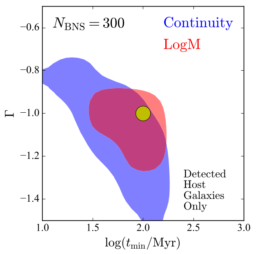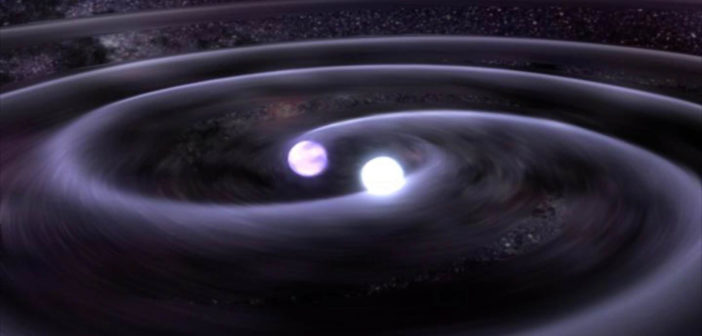To predict how often binary neutron star mergers occur, we need to know when binary neutron stars are born and how long it takes them to merge. An avenue for understanding this is to carefully study their host galaxies.
Where To Look?
Neutron stars are the seemingly anticlimactic remnants of supernovae. However, aside from containing fascinating states of matter, they may also be responsible for creating some of the elements that can’t be created in the cores of normal stars. This would happen when a pair of neutron stars — binary neutron stars (BNS) — merge, emanating characteristic gravitational waves.
Proving this hypothesis of element formation requires an understanding of where and when BNS form and collide. This is where Delay Time Distributions come in. The Delay Time Distribution for binary neutron stars predicts how long after a binary birth two neutron stars will spend spiraling around each other before they finally merge. If we obtained a well-constrained Delay Time Distribution for BNS, we would have a more complete idea of how often BNS form and merge.

The likelihood of different rates of BNS mergers, given Delay Time Distributions with different parameters. The top plot assumes a slow, continuous star formation history and the bottom plot assumes a single burst of star formation. Click to enlarge. [Adapted from Safarzadeh et al. 2019]
Modeling Star Formation Histories
Past efforts by Safarzadeh and collaborators have previously studied the BNS Delay Time Distribution using the properties of BNS merger hosts — specifically galaxy mass and redshift. Both quantities can be broadly tied to a galaxy’s star formation history, which is key to constraining the Delay Time Distribution. In this work, the authors attempt to more directly examine the star formation histories of the merger hosts.
They start by modeling star formation histories for about 6,000 galaxies that were observed in the Galaxy and Mass Assembly survey. From this modeling, two sorts of histories emerge: one where stars formed quickly and nearly all at once and the other where star formation happened slowly and continuously.
A given star formation history can be used to estimate the number of BNS that are born in a galaxy over time. The authors then use a subset of their galaxy sample with the different star formation histories to simulate several sets of BNS mergers. By comparing these simulations to current and future observations of BNS merger rates, the authors succeed in placing new constraints on the BNS Delay Time Distribution parameters.

Constraints on Delay Time Distribution parameters obtained using a sample of 300 BNS merger host galaxies. The input function is marked by the yellow circle, the red region comes from assuming a burst of star formation, and the blue region comes from assuming slow, continuous star formation. [Safarzadeh et al. 2019]
In Search of More
Using star formation histories to constrain Delay Time Distributions proves to be an improvement over using galaxy masses. Additionally, the simulations provide a larger sample of BNS host galaxies to work with. However, the best results will be obtained when we eventually build a larger sample of observed BNS mergers that spans a much larger volume of space.
Given that gravitational wave astronomy is in its infancy, our sample of BNS mergers is likely to explode as new observatories come online. Will this tell us more about how binary neutron stars form, collide, and brew the chemical elements that pervade our universe? Likely so!
Citation
“Measuring the Delay Time Distribution of Binary Neutron Stars. III. Using the Individual Star Formation Histories of Gravitational-wave Event Host Galaxies in the Local Universe,” Mohammadtaher Safarzadeh et al 2019 ApJL 878 L14. https://doi.org/10.3847/2041-8213/ab24e3

5 Comments
Pingback: Astronomers ponder Odd Radio Circles in space – Valerian's Realm
Pingback: Astronomers ponder Odd Radio Circles in space | Space – MOVIES MANIA
Pingback: Why Don’t Light & Gravitational Waves Arrive At Same Time? - Knowledge Area 51
Pingback: Smashing Neutrons: On the Origin of Extreme r-process Enhanced Stars | astrobites
Pingback: Smashing Neutrons: On the Origin of Extreme r-Process Enhanced Stars